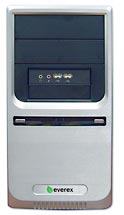Wal-Mart's $200 PC - sold out

About two weeks ago, Wal-Mart began selling $200 Linux-based PC. The initial run was around 10,000 units. Now Wal-Mart is sold out. Has Linux now found a niche?

One thing that interested me about this PC is that it is shipped in a tower case when the components would fit into a much smaller case. I wondered why this was the case until I came across a write-up on Wired:
Even at the low end, however, image is everything. The gPC is built using tiny components, but put inside a full-size case because research indicates that Wal-Mart shoppers are so unsophisticated they equate physical size with capability.
That "Wal-Mart shoppers are so unsophisticated" bit is a tad worrying because I do wonder whether someone who equates case size with capability should be put in charge of a Linux system. The reviews seem pretty positive though. Maybe Wired have underestimate the kind of person who shops at Wal-Mart. Positive reviews far outweigh negative ones. However, the comment that stood out was this:
when you want to jazz it up, just spend 10 bucks for a new linux distro
Interesting comment, eh?
Now here's what's interesting about this PC. It doesn't have what it takes to run Windows Vista, but it has more than enough power to do pretty much everything that users want from a PC. As hardware costs have plummeted, and the power that can be squeezed from components increased, the cost of having Windows installed on such a PC becomes too high a proportion of the cost of components. For example, if you wanted to load Windows Vista Home Basic onto this system (not that I'd suggest that you tried - the PC just couldn't cope with Vista), you're adding between $60 and $90 to the cost of the PC (depending on what the vendor pays for an OEM license, if you do it yourself, expect to pay the higher price in this spectrum). In fact, Wal-Mart do sell a similar system with Home Basic pre-installed (this system has an extra 512MB of RAM, a SATA 150 drive instead of an ATA 150 hard drive, and comes with a keyboard and mouse) for $298. Add Microsoft Office to that cost and the price of software doubles the price of the hardware. By installing Linux and OpenOffice, the total cost of the PC is kept as low as possible. While the price of hardware has fallen dramatically, the price of Windows hasn't. This could be Microsoft's Achilles' Heel. This low price point will appeal to many.
Has Linux finally found a niche in which it can compete against Windows or will the interest in these kinds of systems be limited? I think that Linux might well have found a good niche. Sure, these low-end systems will never appeal to those who want power at any cost (and who don't mind if their systems belch black smoke to achieve that power) but for people looking for a very cheap PC at a rock bottom price (this system is so cheap that I doubt you could build one for as good a price if you added shipping charges for the components into the deal), this must be a pretty irresistible deal.
Maybe a more relevant question is not whether Linux has found a niche, but whether Windows has outgrown the average user?
Thoughts?